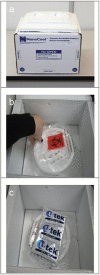The Influence of Social Conditions Across the Life Course on the Human Gut Microbiota: A Pilot Project With the Wisconsin Longitudinal Study
- PMID: 28444239
- PMCID: PMC5926979
- DOI: 10.1093/geronb/gbx029
The Influence of Social Conditions Across the Life Course on the Human Gut Microbiota: A Pilot Project With the Wisconsin Longitudinal Study
Abstract
Objective: To test the feasibility of collecting and integrating data on the gut microbiome into one of the most comprehensive longitudinal studies of aging and health, the Wisconsin Longitudinal Study (WLS). The long-term goal of this integration is to clarify the contribution of social conditions in shaping the composition of the gut microbiota late in life. Research on the microbiome, which is considered to be of parallel importance to human health as the human genome, has been hindered by human studies with nonrandomly selected samples and with limited data on social conditions over the life course.
Methods: No existing population-based longitudinal study had collected fecal specimens. Consequently, we created an in-person protocol to collect stool specimens from a subgroup of WLS participants.
Results: We collected 429 stool specimens, yielding a 74% response rate and one of the largest human samples to date.
Discussion: The addition of data on the gut microbiome to the WLS-and to other population based longitudinal studies of aging-is feasible, under the right conditions, and can generate innovative research on the relationship between social conditions and the gut microbiome.
Keywords: Biodemography; Health disparities; Survey methods.
© The Author 2017. Published by Oxford University Press on behalf of The Gerontological Society of America. All rights reserved. For permissions, please e-mail: journals.permissions@oup.com.
Figures



Similar articles
-
Wisconsin microbiome study, a cross-sectional investigation of dietary fibre, microbiome composition and antibiotic-resistant organisms: rationale and methods.BMJ Open. 2018 Mar 27;8(3):e019450. doi: 10.1136/bmjopen-2017-019450. BMJ Open. 2018. PMID: 29588324 Free PMC article.
-
Urinary lead concentration and composition of the adult gut microbiota in a cross-sectional population-based sample.Environ Int. 2019 Dec;133(Pt A):105122. doi: 10.1016/j.envint.2019.105122. Epub 2019 Sep 10. Environ Int. 2019. PMID: 31518933 Free PMC article.
-
Feasibility of self-collection of fecal specimens by randomly sampled women for health-related studies of the gut microbiome.BMC Res Notes. 2014 Apr 1;7:204. doi: 10.1186/1756-0500-7-204. BMC Res Notes. 2014. PMID: 24690120 Free PMC article.
-
Effects of Stool Sample Preservation Methods on Gut Microbiota Biodiversity: New Original Data and Systematic Review with Meta-Analysis.Microbiol Spectr. 2023 Jun 15;11(3):e0429722. doi: 10.1128/spectrum.04297-22. Epub 2023 Apr 24. Microbiol Spectr. 2023. PMID: 37093040 Free PMC article.
-
Emerging role of fecal microbiota therapy in the treatment of gastrointestinal and extra-gastrointestinal diseases.J Physiol Pharmacol. 2015 Aug;66(4):483-91. J Physiol Pharmacol. 2015. PMID: 26348073 Review.
Cited by
-
Assessing Dementia Prevalence in the Wisconsin Longitudinal Study: Cohort Profile, Protocol, and Preliminary Findings.J Alzheimers Dis. 2021;81(2):751-768. doi: 10.3233/JAD-201422. J Alzheimers Dis. 2021. PMID: 33843672 Free PMC article.
-
Social and population health science approaches to understand the human microbiome.Nat Hum Behav. 2018 Nov;2(11):808-815. doi: 10.1038/s41562-018-0452-y. Epub 2018 Oct 22. Nat Hum Behav. 2018. PMID: 31457107 Free PMC article.
-
Microbial Transplantation With Human Gut Commensals Containing CutC Is Sufficient to Transmit Enhanced Platelet Reactivity and Thrombosis Potential.Circ Res. 2018 Oct 26;123(10):1164-1176. doi: 10.1161/CIRCRESAHA.118.313142. Circ Res. 2018. PMID: 30359185 Free PMC article. Clinical Trial.
-
Gut bacterial taxonomic abundances vary with cognition, personality, and mood in the Wisconsin Longitudinal Study.Brain Behav Immun Health. 2020 Oct 9;9:100155. doi: 10.1016/j.bbih.2020.100155. eCollection 2020 Dec. Brain Behav Immun Health. 2020. PMID: 34589897 Free PMC article.
-
"Under the Skin" and into the Gut: Social Epidemiology of the Microbiome.Curr Epidemiol Rep. 2018;5(4):432-441. doi: 10.1007/s40471-018-0167-7. Epub 2018 Sep 20. Curr Epidemiol Rep. 2018. PMID: 30596004 Free PMC article. Review.
References
-
- Bailey M. T., Coe C. L. (1999). Maternal separation disrupts the integrity of the intestinal microflora in infant rhesus monkeys. Developmental Psychobiology, 35, 146–155. - PubMed
-
- Bailey M. T., Dowd S. E., Galley J. D., Hufnagle A. R., Allen R. G., Lyte M. (2011). Exposure to a social stressor alters the structure of the intestinal microbiota: Implications for stressor-induced immunomodulation. Brain, Behavior, and Immunity, 25, 397–407. doi:10.1016/j.bbi.2010.10.023 - PMC - PubMed
-
- Baker M., Stabile M., Deri C. (2004). What do self-reported, objective measures of health measure?Journal of Human Resources, 39, 1067–1093. doi:10.3368/jhr.XXXIX.4.1067
Publication types
MeSH terms
Grants and funding
LinkOut - more resources
Full Text Sources
Other Literature Sources

